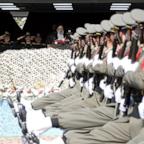Excerpt: 'The South Beach Diet'
Oct. 26, 2004 -- -- "The South Beach Diet," a best-selling book by Miami cardiologist Arthur Agatston, isn't simply a low-carb diet. The basic principles of the diet are to eat good fats, lean protein, plenty of fiber and good carbohydrates.
During stage one, dieters cut out "bad carbohydrates," like bread and potatoes and all sugars -- including fruits and alcohol.
In phase two, whole grains and fruits are gradually reintroduced, leading to slower weight loss.
Dr. Agatston's goal is to follow phase two as a lifestyle, rather than a diet, leading to permanent weight loss.
But what if you have to lose weight quickly for an event like your wedding or your high school reunion?
Dr. Agatston says you can safely "turbo-charge" the South Beach diet by going back to phase one for a short period of time.
Find out more about the diet by reading the following excerpt from "The South Beach Diet: The Delicious, Doctor-Designed, Foolproof Plan for Fast and Healthy Weight Loss."
EXCERPT
GOOD CARBS, BAD CARBS
I'm not a diet doctor.
In fact my career in medicine has been largely devoted to the science of noninvasive cardiac imaging -- the development of technology that produces sophisticated pictures of the heart and the coronary blood vessels. This allows us to identify problems and treat them early, before they cause heart attack or stroke. In CT (computerized tomography) scanning all over the world, I'm proud to say, the measure of coronary calcium is called the Agatston Score, and the protocol for calcium screening is often referred to as the Agatston Method. I maintain an active, full-time cardiology practice, both clinical and research.
So how is it that I am also responsible for a weight-loss program that has become a phenomenon here in South Florida, a regimen that's helped countless women and men -- many of them in their twenties and thirties, young enough to be the grandchildren of my usual cardiology patients -- get down to string-bikini and Speedo-swim-trunks-shape?
I have to admit, I wasn't prepared to find myself on the receiving end of so much buzz. I'm now regularly stopped by people who have seen my TV news appearances or read about the diet's success in newspapers and magazines. Given this city's worldwide image as a mecca of physical beauty and body consciousness and its role as a chic outpost of the fashion industry, it's an unexpected position in which to find myself.
This all started as a serious medical undertaking. Back in the mid-'90s I was but one of many cardiologists who had grown disillusioned with the low-fat, high-carbohydrate diet that the American Heart Association recommended to help us eat properly and maintain healthy weight. None of the low-fat regimens of that era seemed to work reliably, especially over the long haul. My concern was not with my patients' appearance: I wanted to find a diet that would help prevent or reverse the myriad of heart and vascular problems that stem from obesity.
I never found such a diet. Instead, I developed one myself.
Today, I feel nearly as comfortable in the world of nutrition as I do among cardiologists. I speak regularly before physicians, researchers, and other health-care professionals who devote their lives to helping patients eat sensibly and lose weight. Although my interest in diet started from the therapeutic perspective, I see now that the cosmetic benefits of losing weight are extremely important because they so effectively motivate the young and the old -- even more than the promise of a healthy heart, it often seems. The psychological lift that comes from an improved appearance benefits the entire person, and keeps many a patient from backsliding. The end result is cardiovascular health -- my only goal when this journey began.
What started as a part-time foray into the world of nutrition has led me to devise a simple, medically-sound diet that works, without stress, for a large percentage of those who try it. This program has been scientifically studied (as few diets ever are) and proven effective, both for losing weight and for getting and keeping a healthy cardiovascular system.
Back when this all began, of course, I had no idea what would ensue. All I knew was that many of my patients -- more of them every year -- were overweight and that their condition was a big part of their cardiac risk. I could treat them with all the newest medications and procedures, but until they got their diet under control we were often fighting a losing battle. Their eating habits contributed to blood chemistry that was dangerously high in cholesterol and triglycerides, the leading factors in blocked arteries and inflammation of the blood vessels. And there was another, not terribly well-understood diet-related problem that they shared, a silent, so-called metabolic syndrome (prediabetes) found in close to half of all Americans who suffer heart attacks.
My journey to disease prevention through diet actually began when my education as a cardiologist did, 30 years ago. During my training in the late 1970s, I looked forward to treating patients with heart disease -- despite the fact that we didn't have many preventive weapons in our arsenal. I asked the most respected cardiologist I knew this question: "What is the best way to prevent heart disease?" His answer: "Pick the right parents." If you inherited the gene for cardiac longevity, you were likely to live to a ripe old age. If heart disease struck early in your family, there was not much you could do to change your destiny.




